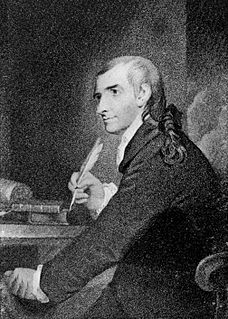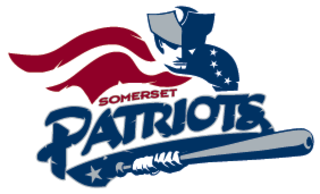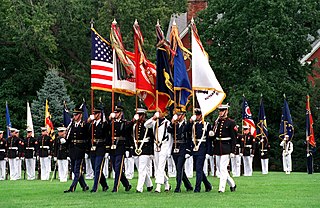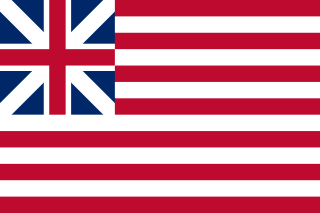
Francis Hopkinson was an author and composer. He designed Continental paper money, the first United States coin, and early versions of the American flag. He was also one of the signers of the Declaration of Independence in July 1776, as a delegate from New Jersey. He served in various roles in the early United States government including as a member of the Second Continental Congress and as a member of the Navy Board. He later became the first federal judge of the Eastern District Court of Pennsylvania on September 30, 1789.

The flag of the United States of America, often referred to as the American flag or U.S. flag, is the national flag of the United States. It consists of thirteen equal horizontal stripes of red alternating with white, with a blue rectangle in the canton bearing fifty small, white, five-pointed stars arranged in nine offset horizontal rows, where rows of six stars alternate with rows of five stars. The 50 stars on the flag represent the 50 states of the United States of America, and the 13 stripes represent the thirteen British colonies that declared independence from the Kingdom of Great Britain, and became the first states in the U.S. Nicknames for the flag include the Stars and Stripes, Old Glory, and the Star-Spangled Banner.

The Continental Congress was initially a convention of delegates from a number of British American colonies at the height of the American Revolution, who acted collectively for the people of the Thirteen Colonies that ultimately became the United States of America. After declaring the colonies independent from the Kingdom of Great Britain in 1776, it acted as the provisional governing structure for the collective United States, while most government functions remained in the individual states. The term most specifically refers to the First Continental Congress of 1774 and the Second Continental Congress of 1775–1781. More broadly, it also refers to the Congress of the Confederation of 1781–1789, thus covering the three congressional bodies of the Thirteen Colonies and the United States that met between 1774 and the inauguration of a new government in 1789 under the United States Constitution.

The Great Seal of the United States is used to authenticate certain documents issued by the federal government of the United States. The phrase is used both for the physical seal itself, which is kept by the United States Secretary of State, and more generally for the design impressed upon it. The Great Seal was first used in 1782.

The Somerset Patriots are an American professional baseball team based in Bridgewater Township, New Jersey. They are a member of the Liberty Division of the Atlantic League of Professional Baseball, which is not affiliated with Major League Baseball. From the 1999 season to the present, the Patriots have played their home games at TD Bank Ballpark.

The Second Continental Congress was a meeting of delegates from the Thirteen Colonies in America which united in the American Revolutionary War. It convened on May 10, 1775 with representatives from 12 of the colonies in Philadelphia, Pennsylvania shortly after the battles of Lexington and Concord, succeeding the First Continental Congress which met in Philadelphia from September 5 to October 26, 1774. The Second Congress functioned as a de facto national government at the outset of the Revolutionary War by raising armies, directing strategy, appointing diplomats, and writing treatises such as the Declaration of the Causes and Necessity of Taking Up Arms and the Olive Branch Petition. All thirteen colonies were represented by the time that the Congress adopted the Lee Resolution which declared independence from Britain on July 2, 1776, and the congress agreed to the Declaration of Independence two days later.

The several branches of the United States Armed Forces are represented by flags, with the exception of the U.S. Space Force which has yet to adopt any. Within the U.S. military, various flags fly on various occasions, and on various ships, bases, camps, and military academies.

The First Navy Jack was the naval jack of the United States from 1975 to 1976 and again from 2002 to 2019. It was authorized by the U.S. Navy and was flown from the jackstaff of commissioned vessels of the U.S. Navy while moored pierside or at anchor. It is now only used as a naval jack by the oldest active warship in the U.S. Navy. The design is traditionally regarded as that of the first U.S. naval jack flown in the earliest years of the United States' existence, though this is disputed by the historical record.

Samuel Chester Reid was an officer in the United States Navy who commanded a privateer during the War of 1812. He is also noted for having helped design the 1818 version of the flag of the United States, which first established the rule of keeping thirteen stripes and adding one star for each U.S. state.

The "Grand Union Flag" is considered to be the first national flag of the United States of America.
National symbols of the United States are the symbols used to represent the United States of America.

The Great Seal of the State of Illinois is the official emblem of the state, and signifies the official nature of a document produced by the state of Illinois. The flag of the state of Illinois consists of the seal of Illinois on a white background, with the word "Illinois" underneath the seal. The present seal was adopted in 1869, the flag bearing the central elements of the seal was adopted in 1915, and the word Illinois was added to the flag in 1970.

The ensign of the United States is the flag of the United States when worn as an ensign. International maritime law—see International Treaty on Law of the Sea, articles 91 and 92—provides that vessels have a "national character" and thus should display a flag (ensign) that corresponds to this national character, especially when in international or foreign waters. Vessels that are formally documented under the federal vessel documentation act, vessels owned by government bodies in the United States, and vessels in the U.S. military unquestionably have U.S. national character, and thus properly hoist a U.S. ensign to show their national character. Vessels that are numbered by the states and small, non-registered craft owned by U.S. citizens and not registered in other countries may also hoist a U.S. ensign to show their national character.

Pennsylvania was the site of key events and places related to the American Revolution. The state, and especially the city of Philadelphia, played a critical role in the American Revolution.
The following is a timeline of the flag of the United States.

The Betsy Ross flag is an early design of the flag of the United States, named for early American upholsterer and flag maker Betsy Ross. The pattern of the Betsy Ross flag is 13 alternating red-and-white stripes with stars in a field of blue in the upper left corner canton. Its distinguishing feature is thirteen 5-pointed stars arranged in a circle representing the 13 colonies that fought for their independence during The American Revolutionary War. Since the beginning of the 20th century, the flag has been a popular symbol of American patriotism, though its origin story is based on a questionable family legend.

New England has no official flag, but there have been many historical and modern banners used to represent the New England Colonies or the six states of New England. There are some variations, but common designs include a plain colored field with a pine tree in the canton. The eastern white pine is the most common symbol of New England and often represents that tree's former importance in shipbuilding and New England's maritime culture.

The Cowpens flag, or 3rd Maryland flag, is an early version of the United States flag that meets the congressional requirements of the Flag Resolution of 1777. Like the Betsy Ross flag, the white stars are arranged in a circle on a blue field; but the circle consists of just 12 stars, with the 13th star in the center.

Serapis is a name given to an unconventional, early United States ensign flown from the captured British frigate Serapis.

















